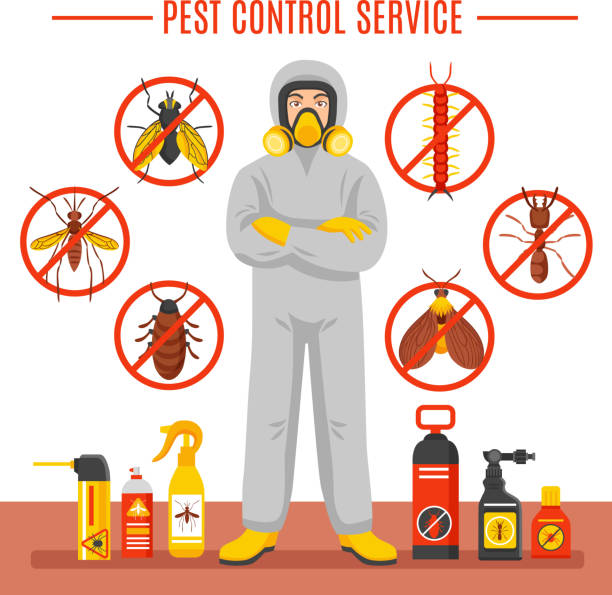Protect your home safe with Pest Control and stop future infestations.
Eco-Friendly Insect Control Approaches for Handling Wild Animals in Urban Locations
Urban locations frequently locate themselves at the intersection of human task and wildlife, leading to special challenges in parasite management. These techniques not only protect the atmosphere but also improve community engagement in wild animals management. As city populaces proceed to expand, comprehending the characteristics of wildlife interactions comes to be progressively important.
Recognizing Urban Wildlife Characteristics
Recognizing Urban Wild animals Characteristics is crucial for establishing efficient and environmentally friendly insect control methods. Urban areas are progressively becoming habitats for different wild animals species, driven by aspects such as environment fragmentation, food accessibility, and human advancement. Identifying these dynamics permits a nuanced strategy to pest management that aligns with environmental concepts.
Urban wildlife frequently consists of types such as raccoons, squirrels, and birds, which adapt to city settings, locating particular niches in eco-friendly spaces, parks, and also houses. Their existence can lead to conflicts with human beings, specifically when they manipulate personnels for food and sanctuary. Comprehending the habits and environmental duties of these varieties notifies techniques that decrease negative interactions while promoting biodiversity.
In addition, acknowledging the interdependencies within metropolitan ecological communities aids in determining important areas for environment preservation and restoration. This understanding adds to the growth of integrated insect monitoring (IPM) strategies that take into consideration the environmental equilibrium, thus lowering reliance on damaging chemicals. By fostering coexistence between people and city wildlife, cities can produce healthier settings that profit both citizens and regional communities, leading the way for sustainable metropolitan living.
Natural Repellents and Deterrents
All-natural repellents and deterrents supply a lasting option to standard bug control methods by using the power of nature to keep undesirable species at bay. These environment-friendly services typically use plant-based components, vital oils, and other naturally taking place materials that prevent bugs without damaging the setting.
One effective all-natural repellent is peppermint oil, which is recognized to repel rats and bugs. Its solid scent is undesirable to many bugs, making it a popular option for city setups. In a similar way, vinegar and citrus peels can offer as deterrents, as their solid smells are normally unattractive to various wild animals.
Furthermore, diatomaceous earth is a natural powder that can be spread out in locations susceptible to bug activity, properly drying out and preventing pests without positioning threats to non-target types. Additionally, garlic sprays and neem oil are recognized for their capability to fend off a variety of pests, consisting of both insects and larger wildlife.
Executing these all-natural repellents not just decreases dependence on chemical pesticides but likewise advertises a healthier metropolitan ecological community, promoting an extra well balanced coexistence between human beings and wildlife. By utilizing these techniques, city areas can properly manage bug populaces while minimizing environmental effect.
Environment Modification Techniques
Efficient environment alteration strategies play an important duty in sustainable insect administration by altering the environment to make it much less for pest problems. By understanding the environmental characteristics of metropolitan areas, residential or commercial property proprietors can apply tactical adjustments that prevent bugs while advertising biodiversity.
(Tentless Termite Treatment)One key technique includes preserving appropriate hygiene. This consists of normal waste removal, securing garbage can, and getting rid of standing water to minimize reproducing websites from this source for pests and rats. In addition, landscape design techniques such as selecting native plants can enhance ecological balance, offering habitats for useful organisms while lessening resources for insects.
Another vital strategy is to seal entry factors in buildings. Inspecting and fixing fractures in structures, walls, and windows can dramatically minimize insect access. Developing physical obstacles, such as fences or plant buffers, can hinder wildlife activity into human-inhabited locations.
Integrated Insect Monitoring Practices
Building upon environment modification strategies, integrated insect administration (IPM) practices offer an alternative technique to regulating parasite populations while minimizing environmental impact. IPM combines numerous approaches, consisting of organic, social, mechanical, and chemical controls, to accomplish efficient insect management.
Organic control involves the intro of natural predators or parasites to reduce insect populations. Social methods, such as plant turning and sanitation, interrupt pest life process and reduce their habitats - Pest control service. Mechanical controls, like catches and obstacles, give immediate relief from bug stress without chemical intervention
Chemical controls are used as a last resource, concentrating on targeted applications that limit harm to non-target types and the atmosphere. The option of eco friendly pesticides, when required, is important to the IPM structure. In addition, keeping track of bug populaces and analyzing possible damages aids educate decision-making, guaranteeing that interventions are prompt and effective.
Neighborhood Involvement and Education And Learning

(Gopher Control)Workshops and informative sessions can furnish residents with understanding concerning indigenous types, habitat conservation, and efficient safe bug administration methods. Cooperation with institutions, local organizations, and government firms further enhances instructional outreach, making sure that important details gets to varied target markets.
Additionally, community-led efforts, such as neighborhood clean-up days and environment reconstruction jobs, not only advertise biodiversity yet likewise strengthen area connections. Pest Control. By encouraging homeowners to share their experiences and observations, communities can create targeted methods that deal with specific neighborhood insect issues
Including comments from residents right into bug management intends allows a more receptive and adaptive strategy to wildlife challenges. Eventually, informed and involved communities are crucial to achieving lasting success in environment-friendly pest control, causing healthier metropolitan settings that value both human and ecological needs.

Verdict
In conclusion, environmentally friendly pest control approaches offer sustainable solutions for handling city wildlife. By focusing on environment modification, using all-natural repellents, and carrying out integrated pest administration practices, areas can foster a harmonious conjunction with regional fauna.